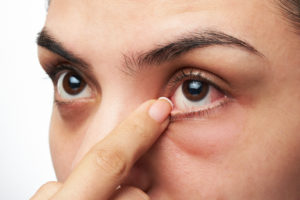Meibomian Gland Dysfunction – A Common Eye Disease with a Common Symptom: Dry Eyes
- Posted on: Mar 15 2016
Meibomian Gland dysfunction (MGD) – What is it?
MGD is a common disease and the leading cause of evaporative dry eye. It involves a chronic abnormality of the meibomian glands, characterized by obstruction in the ducts and/or changes in the glandular secretions. Meibomian glands are located vertically within the eyelid near the lashes, and are responsible for emitting the oil component of tears. Blinking causes oil to be excreted onto the posterior lid margin. The oil is what keeps tears from evaporating too quickly (evaporative dry eye). MGD affects vision because if there is a deficiency of oil in the tear film, it can result in a significant decrease in the quality and clarity of vision.
Symptoms of MGD
The early stages of MGD are often asymptomatic or mild. If left untreated, MGD can cause or worsen eyelid inflammation and dry eye symptoms. The oil glands become blocked with secretions, and chronically blocked glands become unable to secrete oil. This can result in permanent changes in the tear film and dry eyes. Since MGD can pose substantial quality of life issues, it’s especially important to be examined by an ophthalmologist at the appearance of first signs. These include:
-Burning
-Red eyes
-Watering
-Light sensitivity
-Itching
-Dryness
-Stickiness
-Foreign body sensation
-Intermittent blurry vision
Who gets MGD?
MGD can happen to anyone, but it is more common in women and people with acne rosacea, acne vulgaris and seborrheic dermatitis. It’s also more common in people over 50. Hormones may play a role as well.
Meibomian Gland Dysfunction – Treatments
The goal of all MGD treatments is normal tear film stability. This is achieved by improving the flow of meibomian gland secretions. There are numerous standard, traditional treatments that can be utilized to work toward this goal. These consist of warm compresses, lid massage, lid scrub, essential fatty acid supplements, tear substitutes, environmental modifications, meibomian gland probing, topical steroids and antibiotics.
Despite the many available standard treatments, full relief of uncomfortable symptoms has been difficult to achieve. Each of the therapies has a different shortcoming and may provide only partial, temporary relief with limited effectiveness. Some of the therapies are painful, challenging to comply with on a long-term basis, or may result in unwanted side effects. Quite often, the result is frustration for both patient and ophthalmologist.
New Treatment – LipiFlow is Very Effective
A new treatment for MGD has emerged, and it indicates more promising results than conventional methods. It’s called the LipiFlow® Thermal Pulsation System, and Dr. Niki is pleased to now offer this option to patients. MGD is often caused by an obstruction of the meibomian gland, and the LipiFlow® treatment works to clear the obstruction. It combines heat and massage therapy in a 12 minute session with minimal discomfort. Risk of side effects is minimal and, as with any treatment, your ophthalmologist would discuss possible adverse effects in advance. A recent study has shown that LipiFlow® significantly improved both signs and symptoms of MGD in a safe and effective way. If you’d like more information on the LipiFlow® system, please call the office or make an appointment with Dr. Niki.
Want to learn more about the treatments we offer? Click here for more information.
Do you need help with scheduling your appointment? Call us today!
Posted in: Eye Care, Eye Conditions



